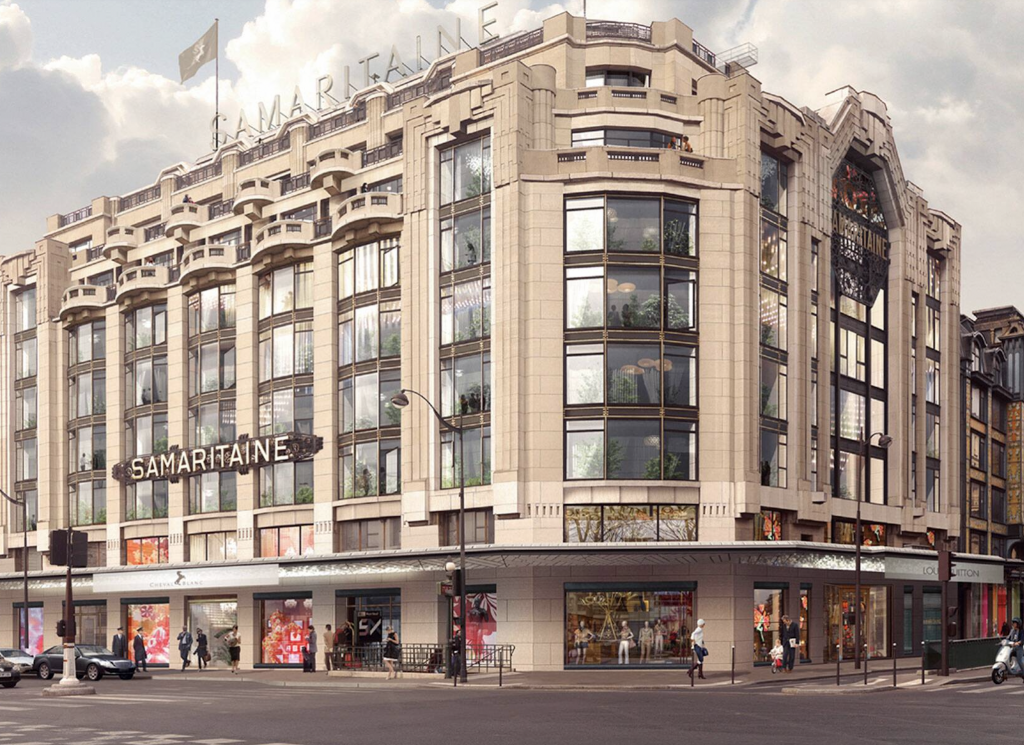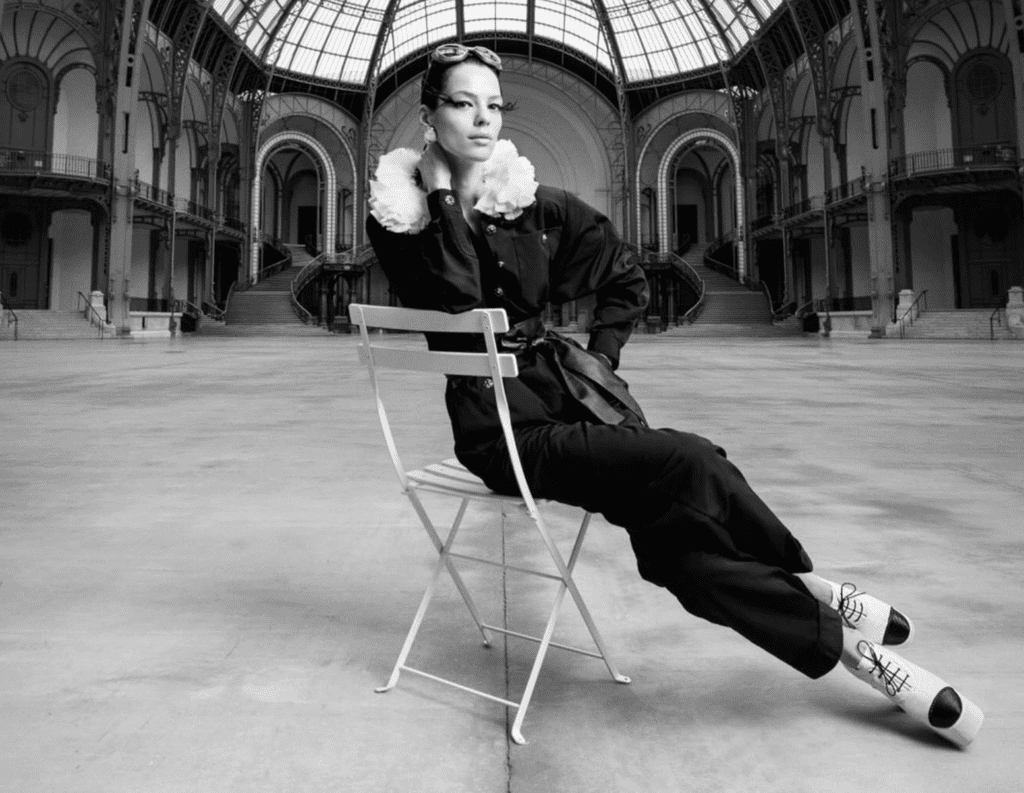A $1 billion-plus shopping mecca “for the super-rich” was slated to welcome the public into its glitzy enclave dab-smack in the heart of Paris in the spring of 2020. The property of luxury goods conglomerate LVMH Moët Hennessy Louis Vuitton, La Samaritaine – a sweeping 152-year old shopping destination located steps from the Seine, a short stroll from the main courtyard of the Louvre, and not terribly far from in-the-midst-of-rebuild Notre Dame – revealed that it would open its doors almost two decades after the mighty LVMH first swooped in with its deep pockets and grand plans to revamp the iconic site and 16 years after the shopping center was forced to go dark due to its failure to meet various significant building safety codes.
When La Samaritaine opens to the public for the first time in 16 years (the date of which has been pushed back on more than one occasion, in part as a result of the COVID-19 pandemic), Paris-based LVMH plans to use it to “grab a greater slice of tourist spending in Paris,” according to Bloomberg. Thanks to offerings from “more than 600 brands,” the result of a partnership between LVMH and duty-free retailer DFS, as well as a 5-star hotel (going nightly rates are expected to top $1,270), a Christian Dior-branded spa, apartments, and a swathe of ritzy restaurants, the Samaritaine is expected to draw “several millions of visitors per year.”
Any impending shopping or spa-ing or restaurant-going that unfolds under La Samaritaine’s art nouveau glass roof and amidst its resorted Belle Epoque glamour does not come without a history of striking squabbles that left the future of the cluster of four magasins in Paris’ First Arrondissement in limbo for years. The back-and-forth surrounding the project was so drawn out and at times, unpredictable, that when LVMH’s chief financial officer Jean-Jacques Guiony hosted some of the earliest invitees to the space in November 2019, he welcomed them with the caveat, “There were times when I wondered if I would ever be able to say those words.”
Despite years of sets backs and the onset of a global health pandemic that has brought most overseas travel to a screeching halt, and the complications that have come with that, LVMH’s plan to restore La Samaritaine came simply enough in the late 1990s, early 2000s. Fresh off a successful endeavor to acquire and refurbish/rebrand the now-nearly 200-year old Le Bon Marché – Paris’ first department store – in the mid-to-late 1980s and turn it into what the group calls one of “the most exclusive shops in Paris,” LVMH was seemingly looking to further bolster its real estate footprint close to home.
So, the Bernard Arnault-run conglomerate – now 33 years old and the owner of approximately 75 brands, ranging from Louis Vuitton and Dior to Moet & Chandon and Veuve Clicquot – set its sights on La Samaritaine and acquired a 55 percent stake in the company (and its real estate) in 2001 for €256 million. Noting the appeal of the property in its 20-F filing with the Securities and Exchange Commission (“SEC”) for 2002, LVMH described the Samaritaine as “one of the first and most emblematic department stores in Paris,” situated in “a high-growth strategic district [that] attracts both local customers and has a high potential with international visitors.”
LVMH’s Plans
When LVMH entered into the picture, the department store, which had been operating at a loss since the 1970s, was certainly in need of a revamp. And LVMH – in the midst of building what would unquestionably become the most valuable luxury goods conglomerate in the world – could certainly provide support. By the end of 2002, the group asserted in an SEC filing that “with its help, La Samaritaine [had] developed a new growth strategy and started repositioning itself in the fashion and accessories sector, all in order to increase the franchise’s appeal to younger customers with strong purchasing power and at the leading edge of fashion trends.”
But LVMH’s plans – which included renovating the Samaritaine’s famed grands magasins while keeping the department store open in furtherance of what it forecasted as “steady growth for [the business] beginning in 2003” – would come to an abrupt halt before then. In June 2005, just a few years after its initial acquisition, the department store was forced to close, with city officials citing a host of safety issues in connection with the steel and glass portion of the main Samaritaine outpost, (i.e., Magasin 1).
That, however, was only the tip of the iceberg of what was to come.
The department store’s closure – quite possibly “for several years” due to the need for “urgent” and expansive renovations – was met with “staged sit-ins by hundreds of employees on the last day of trading amid fears that the store’s owner LVMH [would] decide not to reopen it,” the Globe & Mail reported at the time. While LVMH denied any plans to “close the store for good and convert the building into office space,” it went back to the drawing board, nonetheless.
What LVMH returned with was a $500 million-plus plan to transform the grand structure and its various corresponding buildings into mixed-use space. It would keep some of the department store alive via an array of branded stores, while adding offices, a luxury hotel, and social housing. The arguably innovative idea did not find favor amongst one major player in the equation: La Samaritaine’s minority shareholder, the Cognacq-Jay Foundation, a charitable fund set up by Samaritaine’s founders Ernest Cognacq and Louise Jay in 1916.
The two sides butted heads over what the future would look like for the sweeping space that first opened in 1869 at the center of the city’s most tourist-heavy district and which was named a historic national monument by the French Ministry of Culture 121 years later in 1990.
After “fighting firmly for a new Samaritaine department store more in line with their founder’s mission,” including an emphasis on “helping businesses to engage with the social sector,” representatives for the Cognacq-Jay Foundation – which ultimately held a 40.6 percent stake in the business to LVMH’s 59.4 percent” – “walked out of talks to reopen the distinctive building in protest of what it called the irresponsible attitude of LVMH,” the Guardian revealed in December 2008.
The Foundation’s president Georges Renand formalized the move in “a stinging letter,” alerting La Samariatine’s then-president (and the former chairman of Le Bon Marché) Philippe de Beauvoir that the Foundation would no longer participate in negotiations about the future use of the iconic site. The Foundation then proceeded to declare in a public-facing statement that the“resignation reflects our deep and fundamental disagreement with the majority shareholder … on the future of Samaritaine.”
“We are letting the majority shareholder” – LVMH – “take sole responsibility for its decisions, which have in any case always been made despite our opposition,” the Foundation declared.
A Short-Lived Victory
The messy working relationship between the two entities would sort itself out by 2010 when LVMH bought out the Cognacq-Jay Foundation’s stake, thereby, becoming the sole owner, and things began to look up. In December 2012, LVMH was granted the necessary building permits it had been waiting on for more than a year in order to transform the Seine-facing and Rue de Rivoli sides of La Samaritaine. That victory was short-lived, though. Within two months of the permits being granted, an appeal was lodged about the work that LVMH was planning to do on the two sides of the Samaritaine.
It turns out, as LVMH was preparing to break ground on its masterpiece, someone was waiting to stop them. Alexandre Gady – the president of the Society for the Protection of Landscapes and Aesthetics in France at the time and “perhaps the preeminent historian of Paris of his generation,” in the words of the New Yorker – was that someone. To put a stop to the Samaritaine-specific alteration of the city’s historic center, he initiated legal proceedings, including two formal requests for cancellation of the Seine and Rue de Rivoli permits.
Gady, along with heritage groups Society for the Protection of Landscapes and Aesthetics and SOS Paris, argued that the city of Paris was not considering its urban planning regulations when it granted the permits to LVMH. In accordance with those regulations, any new construction must take into account the characteristics of the facades of neighboring buildings, as well as the facade of the building it is replacing. LVMH’s plans for La Samaritaine – including the nearly $500 million redevelopment planned by Japanese architect duo SANAA, which would see the demolition of several structures at the rear of the Samaritaine site and the replacement of a facade that stretched for almost an entire block with “a set of etched glass waves” – did not fit the bill.
In fact, not only did LVMH’s plans – which would serve to “merge multiple structures, built between the 1600s and the 1930s and progressively annexed to the Art Nouveau,” per Bloomberg – not fit the bill, in the eyes of the groups, they also argued that such large-scale alterations would “distort the center of Paris.” On the other hand, LVMH, developers, and a select politician or two, including the then-new mayor of Paris Anne Hidalgo pointed to the “boon” that the revamped destination would provide for the local economy.
The matter would make its way in and out of various courts in Paris between late 2012 and the summer of 2015, with LVMH winning some rounds, and Gady and Co. landing victories in others, such as a favorable decision from the Tribunal Administratif, a French administrative court, which rejected LVMH’s permit for the Rue de Rivoli construction in January 2015.
In response to being handed the unfavorable Rue de Rivoli decision, Arnault – who holds the title of the richest man in France (and the second richest in the entire world) – told Reuters that his group would not back down, and instead, would escalate the matter to France’s supreme administrative court, and that is exactly what LVMH did. After all, such legal quandaries were hardly unchartered terrain for LVMH; construction for the Frank Gehry-designed Fondation Louis Vuitton, for instance, stretched over 8 years, in large part thanks to formal resistance (and legal proceedings) from the Coordination for the Safeguarding of the Bois de Boulogne. It would prove to take years, sizable legal bills, and the passage of a special national French law for that cultural epicenter to come into fruition.
However, just as in the case of the Fondation Louis Vuitton, LVMH and its chairman ultimately got their way for La Samaritaine.
Bringing Modernity to Paris
In June 2015, just over a year after Tribunal Administratif approved the permit for the construction on the Seine-facing side of the property, a decision from the Conseil d’Etat – the highest court in France for issues and cases involving matters of public administration – approved the building permit for the renovation of the building located on Rue de Rivoli. According to the Conseil d’Etat, the lower courts had interpreted city planning regulations far too strictly, so much so that nearly any contemporary or innovative project could never be allowed, something that would not be in anyone’s interest.
“We need to know how to bring modernity to this city, and modernity is not the enemy of heritage,” Paris Mayor Anne Hidalgo said in a statement on the heels of the court’s decision. “Nostalgia is a nice engine for a city, but creation is also a good one.”
LVMH’s ambitious plan could proceed … in its entirety, and the group declared the news in a widely-circulated press release. “Ten years after the closure of La Samaritaine for safety reasons and after many years of litigation, these two permits are therefore now irrevocable,” LVMH announced. “La Samaritaine is preparing to resume this ambitious project for the restoration and renovation of the entire site. The three years of works should generate around 1800 jobs.” Overall, the group proclaimed, once the site is renovated, “it will directly create more than 2200 jobs.”
Reflecting on the soon-to-reopen La Samaritaine almost two decades after LVMH first brought it under its glitzy umbrella, Jean-Jacques Guiony, who spearheaded much of the effort as the CEO of the Samaritaine business (in addition to his role as the CFO of LVMH), says the hard-fought revamp makes sense. In interviews this month, Guiony said that “the Samaritaine has no architectural unity, which isn’t to say it doesn’t have personality.” With that in mind, “It is fitting that there should be a strong architectural gesture of the 21st century to complete this new incarnation.”
Following pandemic-related delays, La Samaritaine is expected to open to the public on June 19.
*This article was initially published on November 21, 2019, and has been updated accordingly.











